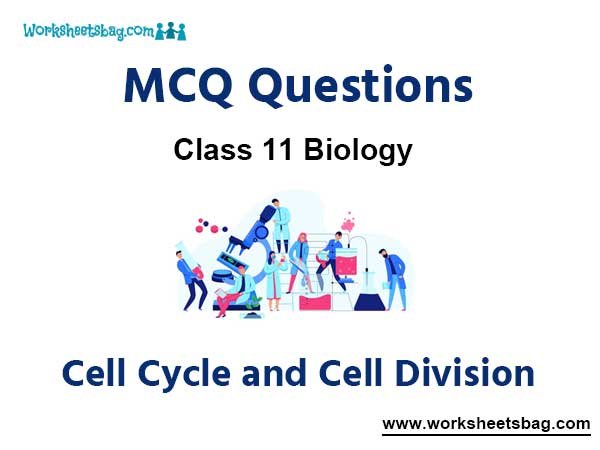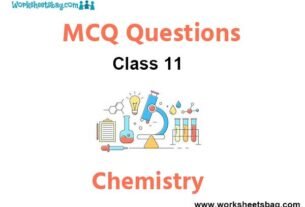Please refer to Cell Cycle and Cell Division MCQ Questions Class 11 Biology below. These MCQ questions for Class 11 Biology with answers have been designed as per the latest NCERT, CBSE books, and syllabus issued for the current academic year. These objective questions for Cell Cycle and Cell Division will help you to prepare for the exams and get more marks.
Cell Cycle and Cell Division MCQ Questions Class 11 Biology
Please see solved MCQ Questions for Cell Cycle and Cell Division in Class 11 Biology. All questions and answers have been prepared by expert faculty of standard 11 based on the latest examination guidelines.
MCQ Questions Class 11 Biology Cell Cycle and Cell Division
Question- Significance of mitosis involves
(a) the growth of multicellular organism.
(b) cell repair.
(c) production of diploid daughter cells with identical genetic complement.
(d) all of the above
Answer
D
Question- Match the description (given in column I) with correct stage of prophase I (given column II) and choose the correct option.
Column I Column II
A. Chromosomes are moved I. Pachytene
to spindle equator
B. Centromere splits and II. Zygotene
chromatids apart
C. Pairing between homologous III. Anaphase
chromosomes takes place
D. Crossing between homologous IV. Metaphase
chromosomes
(a) A – I; B – II; C – III; D – IV
(b) A – II; B – III; C – IV; D – I
(c) A – IV; B – III; C – II; D – I
(d) A – III; B – I; C – IV; D – II
Answer
C
Question- Interphase includes all of the following except ______
(a) G1 phase
(b) Anaphase
(c) S phase
(d) G2 phase
Answer
B
Question- Which of the following statement is not true for homologous chromosome pairs ?
(a) They come from only one of the individual’s parents.
(b) They usually contain slightly different versions of the same genetic information.
(c) They segregate from each other during meiosis I.
(d) They synapse during meiosis I.
Answer
A
Question- Which of the following phase follows S and G2 phases of interphase?
(a) Prophase
(b) Metaphase
(c) Anaphase
(d) Telophase
Answer
A
Question- In mitosis, nucleolus and nuclear membrane disappear at
(a) interphase
(b) prophase
(c) metaphase
(d) telophase
Answer
B
Question- What is the stage of mitosis in which chromosomes are arranged on the equator of spindle?
(a) Anaphase
(b) Prophase
(c) Metaphase
(d) Telophase
Answer
C
Question- Best stage to observe shape, size and number of chromosomes is ______
(a) interphase
(b) metaphase
(c) prophase
(d) telophase
Answer
B
Question- In anaphase of mitosis,
(a) chromosomes get arranged in middle of cell.
(b) nuclear envelope disappears.
(c) chromosome fibres become clear.
(d) chromosomes aggregate at opposite poles to form daughter nuclei.
Answer
D
Question- Which of the following cellular structures always disappears during mitosis and meiosis?
(a) Plastid and nuclear membrane
(b) Nucleolus and nuclear membrane
(c) Endoplasmic reticulum and mitochondria
(d) Endoplasmic reticulum and plasma membrane
Answer
B
Question- In meiosis, division is
(a) Ist reductional and IInd equational.
(b) Ist equational and IInd reductional.
(c) both reductional.
(d) both equational.
Answer
A
Question-. Interkinesis is a
(a) stage between meiosis I and meiosis II.
(b) stage between two mitotic divisions.
(c) interphase.
(d) both (b) and (c)
Answer
A
Question- Synapsis occurs between
(a) spindle fibres and centromeres.
(b) mRNA and ribosomes.
(c) a male and female gamete.
(d) two homologous chromosomes.
Answer
D
Question- During mitosis, nuclear envelope, nucleolous begin to form and ER to reappear at ______
(a) prophase
(b) late metaphase
(c) anaphase
(d) telophase
Answer
D
Question- The synaptonemal complex appears
(a) between homologous chromosomes.
(b) in zygotene stage.
(c) composed of DNA + protein.
(d) All of the above
Answer
D
Question- Chromosome synapsis or bivalent formation occurs in______
(a) leptotene
(b) zygotene
(c) pachytene
(d) diplotene
Answer
B
Question- Crossing over occurs between
(a) sister chromatids of homologous chromosomes.
(b) non-sister chromatids of homologous chromosomes.
(c) sister chromatids of non-homologous chromosomes.
(d) non-sister chromatids of non-homologous chromosomes.
Answer
B
Question- Crossing over occurs during ______
(a) leptotene
(b) pachytene
(c) diplotene
(d) diakinesis
Answer
B
Question- Recombination involves
(a) crossing over
(b) chromosome duplication
(c) spindle formation
(d) cytokinesis
Answer
A
Question- Chiasmata are first seen in ______
(a) leptotene
(b) zygotene
(c) pachytene
(d) diplotene
Answer
D
Question-Which of the following phase is called the resting phase during which cell is preparing for division by undergoing both cell growth and replication of DNA?
(a) M – phase
(b) Prophase
(c) Go phase
(d) Interphase
Answer
D
Question- Select the correct statement with respect to mitosis.
(a) Chromatids separate but remain in the centre of the cell in anaphase.
(b) Chromatids start moving towards opposite poles in telophase.
(c) Golgi complex and endoplasmic reticulum are still visible at the end of prophase.
(d) Chromosomes move to the spindle equator and get aligned along equatorial plate in metaphase.
Answer
D
Question- Terminalization occurs during ______
(a) mitosis
(b) diakinesis
(c) meiosis II
(d) cytokinesis
Answer
B
Question- How many mitotic divisions are needed for a single cell to make 128 cells?
(a) 7
(b) 14
(c) 28
(d) 64
Answer
A
Question- The microtubules of the mitotic spindle attach to a specializes structure in the centromere region of each chromosome called the __________.
(a) Telomere
(b) Centriole
(c) Chromatin
(d) Kinetochore
Answer
D
Question- Find the correctly matched pairs and choose the correct option.
A. Zygotene – Pairing of homologous chromosomes
B. Pachytene – Dissolution of the complexsynaptonemal takes place
C. Diplotene – Bivalent chromosomes appear as tetrads
D. Diakinesis – Terminalization of chiasmata takes place
(a) A and C
(b) A and D
(c) A and B
(d) B and C
Answer
B
Question- Read the following statements about cell division and select the correct statements.
(i) M phase represents the phase when actual cell division occurs and I phase represents the phase between two successive M phase.
(ii) In the 24 hours, average duration of cell cycle of a human cell, cell division proper lasts for only about an hour.
(iii) M phase constitutes more than 95% of the duration of cell cycle.
(a) (i) and (ii)
(b) (ii) and (iii)
(c) (i) and (iii)
(d) (i), (ii) and (iii)
Answer
A
Question- Find out the wrongly matched pair of the stage of prophase I with their feature.
(a) Zygotene – Synaptonemal complex
(b) Pachytene – Mutation
(c) Diplotene – Chiasmata
(d) Diakinesis – Terminalization
Answer
B
Question- Which one of the following precedes re-formation of the nuclear envelope during M phase of the cell cycle ?
(a) Decondensation from chromosomes, and reassembly of the nuclear lamina.
(b) Transcription from chromosomes, and re-assembly of the nuclear lamina.
(c) Formation of the contractile ring, and formation of the phragmoplast.
(d) Formation of the contractile ring, and transcription from chromosomes.
Answer
B
Question- Mitosis and meiosis take place respectively in
(a) meristem and gametangia.
(b) gametangia and meristem.
(c) permanent tissues and secretory tissues.
(d) secretory tissues and permanent tissues.
Answer
A
Question- Which of the following statement(s) is/are true ?
(a) Cell plate represents the middle lamella between the walls of two adjacents cells.
(b) At the time of cytokinesis, organelles like mitochondria and plastids get distributed between the daughter cells.
(c) Cytokinesis in plant cell is centrifugal and takes place by cell-plate formation while animal cells by furrowing/cleavage and is centripetal.
(d) All of the above
Answer
D
Question- In cell cycle, DNA replication takes place in ______
(a) G1 phase
(b) G2 phase
(c) Mitotic metaphase
(d) S phase
Answer
B
Question- In which stage, the chromosomes appear thin and long thread-like ?
(a) Zygotene
(b) Leptotene
(c) Pachytene
(d) Prophase
Answer
B
Question- Which of the following statements related to G0 stage of the cell cycle are correct?
(i) It is a quiescent stage.
(ii) In this phase, cell cycle is stopped.
(iii) G0 cells do not grow or proliferate but metabolically active.
(iv) G0 cells can divide in response to some stimulus.
(a) (i), and (ii)
(b) (i), (ii) and (iii)
(c) Only (i) and (iv)
(d) All of the above
Answer
D
Question- Cell plate grows from
(a) wall to centre
(b) centre to walls
(c) one wall to another
(d) simultaneously
Answer
B
Question- Which one is correct about bivalent ?
(i) Bivalent are tetrads.
(ii) A bivalent means 4 chromatids and 2 centromere.
(iii) One bivalent consists of 2 homologous chromosomes each and sister chromatids.
(iv) Bivalents formation occurs in zygotene.
(a) All of these
(b) Only (iii)
(c) (iii) and (iv)
(d) Only (iv)
Answer
A
Question- Electron micrographs of which stage indicate that chromosomes accompanied by the formation of complex structure called synaptonemal complex?
(a) Zygotene
(b) Pachytene
(c) Diplotene
(d) Diakinesis
Answer
A
Question- Match the terms (given in column I) with their explanation (given in column II) and choose the correct combination from the options given below.
Column I Column II
(Terms) (Explanation)
A. Terminalization I. Pairing of homologous chromosomes.
B. Synapsis II. Point of attachment between homologous chromosomes.
C. Chiasmata III. Nuclear protein complex that helps in adherence of sister chromatids and then
homologous chromosomes.
D. Synaptonemal IV. Shifting of chiasmata outwards complex towards the ends of a bivalent.
(a) A – IV; B – I; C – II; D – III
(b) A – II; B – III; C – IV; D – I
(c) A – II; B – IV; C – III; D – I
(d) A – IV; B – I; C – III; D – II
Answer
A
Question- Which of the following statement(s) is/are correct about S-phase (synthetic phase) ?
(i) It occurs between G1 and G2 phase.
(ii) It marks the period during which DNA replicates.
(iii) At the end of this phase, DNA is doubled but the number of chromosomes remains unchanged.
(iv) As the DNA is doubled in this phase number of chromosomes is also doubled.
(v) Centrioles replicate in this phase.
(vi) Amount of DNA changes from 2C to 4C.
(a) (i), (ii), (iv), (v), (vi)
(b) (i), (ii), (iii), (v), (vi)
(c) All of the above
(d) Only (iv)
Answer
B
Question- Select the correctly matched pair.
A. S phase – DNA replication
B. Zygotene – Synapsis
C. Diplotene – Crossing over
D. Meiosis – Both haploid and diploid cells
(a) A and B
(b) C and D
(c) B and D
(d) A and C
Answer
A
Question-Which phase of cell cycle is known as quiescent stage ?
(a) M phase
(b) G0 phase
(c) G1 phase
(d) S phase
Answer
D
Question- How many meiotic divisions are required to produce 100 pollen grains ?
(a) 25
(b) 50
(c) 100
(d) 125
Answer
A
Question- Choose the mismatch pair.
(a) Karyokinesis – Division of centromere
(b) Cytokinesis – Division of cytoplasm
(c) S-phase – DNA synthesis
(d) Synapsis – Pairing of homologous chromosomes
Answer
A
Question- Which one is correct about crossing over/genetic recombination?
(i) It occurs in tetrad stage which occurs in pachytene of prophase I of meiosis I.
(ii) It occurs between non-sister chromatids of homologous chromosomes.
(iii) It is recombinase enzyme mediated process.
(iv) It is also the reciprocal transfer of genes between the non-homologous chromosomes
(a) All of the above
(b) All except (iv)
(c) (ii), (iii) and (iv)
(d) (iii) and (iv)
Answer
B
Question- Which of the following pair is correctly matched ?
(a) Anaphase I – Homologous chromosomes are separated.
(b) Metaphase I – Pairing of maternal and paternal chromosomes.
(c) Interphase – A nuclear envelop encloses each haploid set of chromosomes.
(d) Prophase I – Non-homologous chromosomes are separated.
Answer
A
Question- In the somatic cell cycle
(a) In G1 phase, DNA content is double the amount of DNA present in the original cell.
(b) DNA replication takes place in S-phase.
(c) a short interphase is followed by a long mitotic phase.
(d) G2 phase follows mitotic phase.
Answer
B
Question- Mark the incorrect pair.
(a) Interphase – S-phase
(b) M phase – Metaphase
(c) Meiosis I – Diplotene
(d) Meiosis II – Diakinesis
Answer
D
Question- During which stages (or prophase I substages) of meiosis do you expect to find the bivalents and DNA replication respectively?
(a) Pachytene and interphase (between two meiotic divisions).
(b) Pachytene and interphase (just prior to prophase I).
(c) Pachytene and S phase (of interphase just prior to prophase I).
(d) Zygotene and S phase (of interphase prior to prophase I).
Answer
D
Question- Significance of meiosis lies in
(a) reduction of chromosome number to one half.
(b) maintaining consistancy of chromosome number during sexual reproduction.
(c) production of genetic variability.
(d) all of the above.
Answer
D
Question- Match the description given in column-I with their stapes given in column-II and identify the correct answer.
Column-I Column-II
A. Initiation of the assembly I. Anaphase
of mitotic spindle
B. Proteins are synthesized in II. Prophase
preparation for mitosis while cell
growth continues.
C. Spindle fibres attach to III. Interphase
kinetochores of chromosomes.
D. Movement of chromatids IV. Metaphase
towards opposite poles
The correct match is
(a) A – II; B – III; C – IV; D – I
(b) A – III; B – II; C – I; D – IV
(c) A – I; B – III; C – II; D – IV
(d) A – IV; B – III; C – I; D – II
Answer
A
Question- If you are provided with root-tips of onion in your class and are asked to count the chromosomes, which of the following stages can you most conveniently look into?
(a) Metaphase
(b) Telophase
(c) Anaphase
(d) Prophase
Answer
A
Question- In which stage of the cell cycle, histone proteins are synthesized in a eukaryotic cell?
(a) During G2 stage of prophase.
(b) During S-phase.
(c) During entire prophase.
(d) During telophase.
Answer
B
Question- Which of the following pair is correctly matched ?
(a) G1 – Second growth phase
(b) S – Duplication phase
(c) G2 – Synthesis phase
(d) G0 – Quiescent stage
Answer
D



